Oskar Messter was the 'Father of the German Film Industry'. This film pioneer founded his production company Messter-Film in the early years of cinema. The main star of the studio was Henny Porten, who already made her film debut in 1906. Another star was the Danish actor Viggo Larsen. During the 1910s, Messter-Film was one of the dominant German film studios and produced over 300 films, until it was merged into the UFA in 1918.
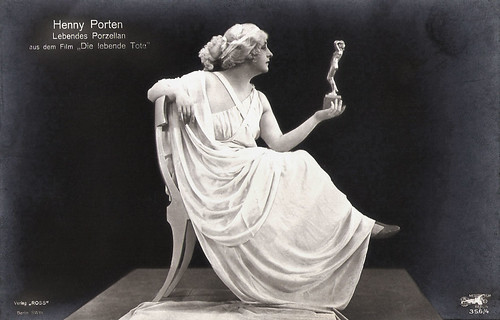
German postcard by Ross Verlag, Berlin, no. 356/4. Photo: Messter-Film. Publicity still for Die lebende Tote/The living dead (Rudolf Biebrach, 1919). Henny Porten appeared in several early films as 'Lebendes Porzellan' (living china).

German postcard by Rotophot in the Film Sterne series, no. 542/6. Photo: Messter-Film. Publicity still of Viggo Larsen in Der Sohn des Hannibal/The Son of Hannibal (Viggo Larsen, 1918).

German postcard by Rotophot in the Film Sterne series, no. 563/1. Photo: Messter-Film, Berlin, Berlin. Publicity still with Viggo Larsen and Ria Jende in Die blaue Mauritius/The Blue Mauritius (Viggo Larsen, 1918).

German postcard by Ross Verlag, no. 401/1. Photo: Rembrandt / Messter Film. Publicity still of Henny Porten in Anna Boleyn (Ernst Lubitsch, 1920).

German postcard by Ross Verlag no. 639/5. Photo: Messter-Film. Publicity still of Emil Jannings and Henny Porten in Kohlhiesels Töchter/Kohlhiesel's Daughters (Ernst Lubitsch, 1920).
Oskar Eduard Messter (1866-1943) was born in Berlin, where his father Eduard had founded in 1859 a company called 'Optisches und Mechanisches Institut Ed. Messter'. This company manufactured and sold eyeglasses, precision medical devices, optical devices for magicians and show businessmen, electric reflectors for theatres, and projectors for the magic lantern.
Oskar finished an education as an optician by his father. This education proved to be essential for his later career. Oskar acquired both business, optical and mechanical skills, which he later applied in cinematography. He took over the management of his father's company in 1895 and only one year later he developed his first own film projector and began to produce cameras and film projectors in series.
This was one of the first projectors using a Geneva drive to achieve the intermittent motion of the film. He is often credited with inventing this application of the Geneva drive, but both Max Gliewe (also in Berlin) and Robert W. Paul in London independently built projectors using this mechanism for film transport at about the same time. Gliewe later joined Messter's company, and together they produced highly successful projectors. By the end of 1896, Messters-Projection Berlin had produced 64 projectors: 42 of these were sold in Germany and 22, in the rest of Europe.
On 15 June 1896, Messter rented a small theatre that had gone bankrupt at 21 Unter den Linden and inaugurated the second cinema hall in Berlin. The first cinema hall was opened by the envoys of the Lumière brothers that precise year. Messter demonstrated his first own short films to an enthusiastic audience. These films were short documentaries of contemporary events and showed partially everyday entities, partially huge occasions. But everything was interesting and fascinating for the film unacquainted audience.
Messter produced such films as Schlittschuhläufer auf der West-Eisbahn/A Skater at the West Rink (1896), Am Brandenburger Tor zu Berlin/At the Brandenburg Gate, Berlin (1896), Umsturz einer Mauer/Subversion of a wall (1897), Stapellauf vom Kreuzer Wilhelm der Grossen/Launch of cruiser Wilhelm the Great (1897), or Seine Majestät Kaiser Wilhelm II in Stettin/His Majesty Kaiser Wilhelm II in Szczecin (1897). In 1897, Messter already offered 84 films showing a wide variety of scenes.
In just four years, the company's profits had multiplied tenfold. In 1900, Oskar formed his own production company in Berlin, Messter Projections. A year later, he restructured his company into separate firms for film production, distribution, and the manufacturing of optical equipment, including film projectors.
Messter presented the Biophon, his method of producing talking films, as the headlining attraction at Berlin's Apollo Theatre in August 1903. Oskar used his Biophon to shoot his first films at the World Fair in Saint Louis, Missouri, in 1904. These films contained a sound-on-disc system.
He also produced 'short films of stage performances, among them Rapunzel (1897), Hänsel und Gretel/Hansel and Gretel (1897), Die bösen Buben/The bad boys (1897), Walküre (1898), Schlussszene des II Aktes aus Der Fall Corignan/Final scene of the II act from The Fall Corignan (1898) and Der verliebte Reservemann/The Reserve man in love (1898).
To his other milestones belong the development of the slow motion camera, the camera for microscopical shots, the realisation of the very first newsreel and the foundation of the Sascha-Messter-Film together with Sascha Kolowrat-Krakowsky. Oskar Messter continued his career as a producer in the new century and he was also always interested in new inventions.

German postcard by Rotophot in the Film Sterne series, no. 500/10. Photo: Messter-Film, Berlin. Publicity still of Henny Porten in Die Prinzessin von Neutralien/The Princess of Neutralia (Rudolf Biebrach, 1917).
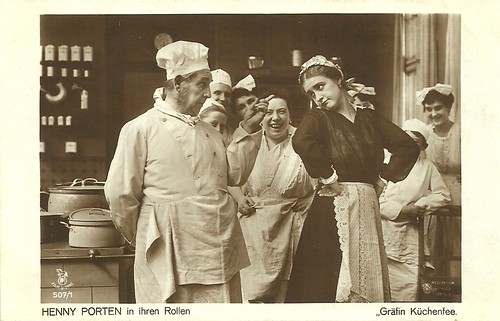
German postcard in the Film Sterne series by Rotophot, no. 507/1. Photo: Messter Film. Publicity still of Henny Porten in Gräfin Küchenfee/Countess Kitchen Fairy (Robert Wiene, 1918).
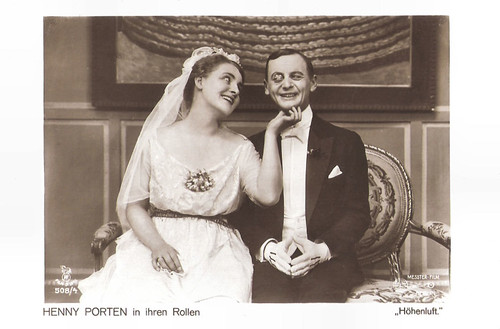
German postcard in the Film Sterne series by Rotophot, no. 508/4. Photo: Messter-Film. Publicity still of Henny Porten and Reinhold Schünzel in the comedy Höhenluft/Mountain air (Rudolf Biebrach, 1917).
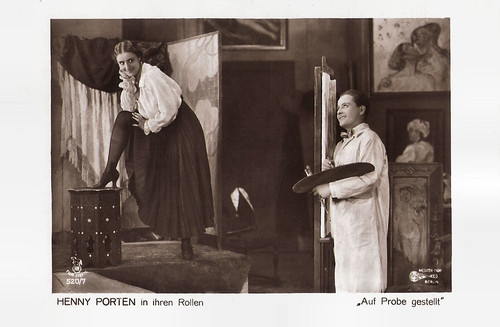
German postcard in the Film Sterne series by Rotophot, no. 520/7. Photo: Messter Film, Berlin. Publicity still of Henny Porten for Auf Probe gestellt/Put to the test (Rudolf Biebrach, 1918).

German postcard by Rotophot in the Film Sterne series, no. 531/5. Photo: Messter Film. Publicity still of Henny Porten and Hermann Thimig in Agnes Arnau und ihre drei Freier/Agnes Arnau and her three suitors (Rudolf Biebrach, 1918).
Messter-Film produced a total of three hundred and twenty six silent films between 1896 and 1918. Until 1910, all of them were short films of very short duration and from 1911, they were already medium-length films and feature films.
When the film became established in the 1910s and many directors made films, Oskar Messter remained an important producer in the film business. In the next years he realised more fiction films and less documentaries.
Many stars of the German silent cinema started their careers in these years in the films of Oskar Messter. Among them were such actors as Emil Jannings, Werner Krauss and Paul Hartmann and actresses as Wanda Treumann and Erna Morena, but also future directors like Robert Wiene and Carl Froelich.
Messter was one of the constructors of "stardom" through his promotion of the actress Henny Porten. Porten had already made her first film appearance in Meißner Porzellan/The Porcelain of Meissner (1906), a very short sound film, directed by her father, Franz Porten, for Oskar Messter. In 1907, after finishing her studies at the De Múgica College for Elderly Daughters, the young Porten became a professional actress. She signed an exclusive contract with Messter and starred in the film Lohengrin (Franz Porten, 1910), based on the opera by Richard Wagner. Although without great box office success at first, her striking appearance and simple style of acting exerted a magnetic effect on the public.
Henny became the first diva of the German cinema with her role as a blind girl in the melodrama Das Liebesglucke der Blinden/The Love of a Blind Girl (Heinrich Bolten-Baeckers, Curt A. Stark, 1910), written by her sister Rosa Porten. People started to ask for her name, and thus the Messter girl became one of the first film stars who was known by name.
In January 1911, Messter concluded a one month contract with Porten, which was repeatedly extended. Until 1918, she would make a hundred films for Messter-Film. In 1912, Porten appeared in Maskierte Liebe/Love Masked (Adolf Gärtner, Curt A. Stark, 1912), the first feature film of the Messters-Projection GmbH, Berlin. In 1913/1914 with the success of Eva (Curt A. Stark, 1913), an 'Autorenfilm', there followed the first of the 'Henny Porten film star series', which began with Der Feind im Land/Faithful Unto Death (Curt A. Stark, 1913).
Rudolf Biebrach, who in earlier films often played her father, now takes on the work of film director. At the end of World War I, Porten films are at the peak of success with German film audiences. The filming of the stage play Rose Bernd (Alfred Halm, 1919) is a big success, which greatly adds to the prestige of cinematography among German educated classes as well as critics.
This success is followed with three more hits, the comedy Kohlhiesels Töchter/Kohlhiesel's Daughters (Ernst Lubitsch, 1920), Monika Vogelsang (Rudolf Biebrach, 1920) and Anna Boleyn (Ernst Lubitsch, 1920). The latter two are among the most expensive projects up till then of Messter-Film. But by then, Oskar Messter has retired and Messter-Film has become part of a huge, new conglomerate...

German postcard in the Film-Sterne series by Rotophot, no. 567/5. Photo: Messter-Film, Berlin. Publicity still of Henny Porten in Die blaue Laterne/The Blue Lantern (Rudolf Biebrach, 1918), based on the novel by Paul Lindau. Porten is visible here in the inn The Blue Lantern.
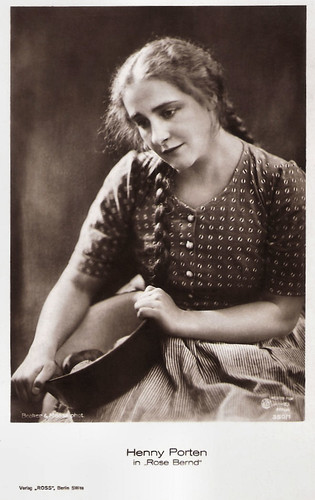
German postcard by Ross Verlag, Berlin, no. 350/1. Photo: Becker & Maass, Berlin / Messter-Film. Publicity still of Henny Porten for Rose Bernd (Alfred Halm, 1919).

German postcard by Ross Verlag, no. 609/2. Photo: Messter-Film, Berlin. Publicity still of Henny Porten in the romantic comedy Ihr Sport/Her Sport (Rudolf Biebrach, 1919).

German postcard by Ross Verlag, no. 633/6. Photo: Messter Film. Publicity still of Henny Porten and Paul Hartmann in Monika Vogelsang (Rudolf Biebrach, 1920).
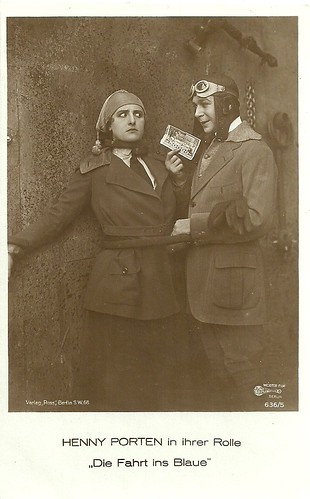
German postcard by Ross Verlag, no. 636/5. Photo: Messter-Film. Publicity still of Henny Porten and Georg Alexander in Die Fahrt ins Blaue/The drive into the blue (Rudolf Biebrach, 1919).
In April 1918, at the end of World War I, Oskar Messter sold all his film companies to the newly founded Universum-Film Aktiengesellschaft (UFA) for 5.3 million gold Marks. His companies became one of the cornerstones of the gigantic concern that would dominate the German film industry until the end of 1945.
Messter himself retired from the active film business in 1918. Aged fifty-seven, he remained very active. From 1922 he actively enlarged his collection of historical film equipment. In 1924 he realised one film for the last time called Der Sprung ins Leben/Leap Into Life (Johannes Guter, 1924) starring Xenia Desni and Walter Rilla. It features one the earliest film appearances of the future star Marlene Dietrich. And in August, 1928, Messter was one of the founders of the Tobis sound film company,
In 1932, Oskar Messter donated his collection of historical film equipment to the Deutsches Museum (German Museum) in Munich. This is the world's largest museum of science and technology, with about 28,000 exhibited objects from 50 fields of science and technology.
In 1936, Messter published his biography called 'Mein Weg mit dem Film' (My way with the cinema), based in part on a decade of meticulous correspondence with all of the living film pioneers and inventors that he could reach.
Oskar Messter died in 1943 at his retirement home on the Tegernsee in Bavaria. He was survived by his second wife Antonie König.
Many seemingly lost Messter films have been found in the Desmet Collection of the EYE Filmmuseum in Amsterdam. After restoration they have been shown at numerous festivals all over the world.

Viggo Larsen. German postcard by Rotophot in the Film Sterne series, no. 84/2. Photo: Karl Schenker / Messter Film, Berlin.

Wanda Treumann. German postcard in the Film Sterne series by Rotophot, no. 87/1. Photo: Karl Schenker / Messter Film, Berlin.
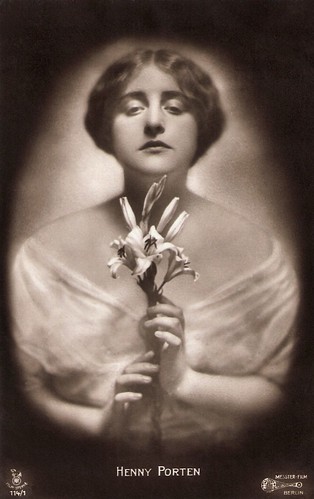
Henny Porten. German postcard by Rotophot in the Film Sterne series, no. 114/1. Photo: Messter Film, Berlin.

Henny Porten. German postcard by Rotophot in the Film Sterne series, no. 115/3. Photo: Messter Film, Berlin.

Erna Morena. German postcard, no. 10. Photo: Karl Schenker, 1914 / Messter-Film.
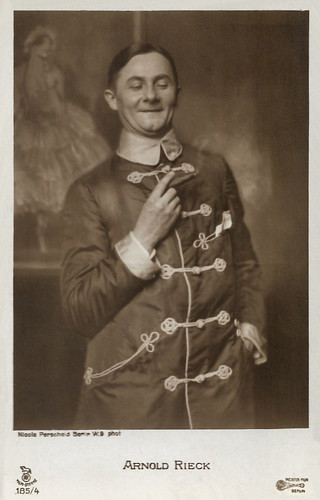
Arnold Rieck. German postcard by Rotophot in the Film Sterne series, no. 185/4. Photo: Nicola Perscheid, Berlin / Messter Film, Berlin.
Living Sculptures: Film Study for Screen Artist (1903) from Lewd Man on Vimeo.
As you can see above, there are many, many Henny Porten postcards. Next Tuesday we will start a weekly series of Film Specials on Henny Porten films. For the fans.
Sources: Deac Rossell (Who's Who of Victorian Cinema?), Filmportal.de, Wikipedia and IMDb.

German postcard by Ross Verlag, Berlin, no. 356/4. Photo: Messter-Film. Publicity still for Die lebende Tote/The living dead (Rudolf Biebrach, 1919). Henny Porten appeared in several early films as 'Lebendes Porzellan' (living china).

German postcard by Rotophot in the Film Sterne series, no. 542/6. Photo: Messter-Film. Publicity still of Viggo Larsen in Der Sohn des Hannibal/The Son of Hannibal (Viggo Larsen, 1918).

German postcard by Rotophot in the Film Sterne series, no. 563/1. Photo: Messter-Film, Berlin, Berlin. Publicity still with Viggo Larsen and Ria Jende in Die blaue Mauritius/The Blue Mauritius (Viggo Larsen, 1918).

German postcard by Ross Verlag, no. 401/1. Photo: Rembrandt / Messter Film. Publicity still of Henny Porten in Anna Boleyn (Ernst Lubitsch, 1920).

German postcard by Ross Verlag no. 639/5. Photo: Messter-Film. Publicity still of Emil Jannings and Henny Porten in Kohlhiesels Töchter/Kohlhiesel's Daughters (Ernst Lubitsch, 1920).
Film pioneer Oskar Messter
Oskar Eduard Messter (1866-1943) was born in Berlin, where his father Eduard had founded in 1859 a company called 'Optisches und Mechanisches Institut Ed. Messter'. This company manufactured and sold eyeglasses, precision medical devices, optical devices for magicians and show businessmen, electric reflectors for theatres, and projectors for the magic lantern.
Oskar finished an education as an optician by his father. This education proved to be essential for his later career. Oskar acquired both business, optical and mechanical skills, which he later applied in cinematography. He took over the management of his father's company in 1895 and only one year later he developed his first own film projector and began to produce cameras and film projectors in series.
This was one of the first projectors using a Geneva drive to achieve the intermittent motion of the film. He is often credited with inventing this application of the Geneva drive, but both Max Gliewe (also in Berlin) and Robert W. Paul in London independently built projectors using this mechanism for film transport at about the same time. Gliewe later joined Messter's company, and together they produced highly successful projectors. By the end of 1896, Messters-Projection Berlin had produced 64 projectors: 42 of these were sold in Germany and 22, in the rest of Europe.
On 15 June 1896, Messter rented a small theatre that had gone bankrupt at 21 Unter den Linden and inaugurated the second cinema hall in Berlin. The first cinema hall was opened by the envoys of the Lumière brothers that precise year. Messter demonstrated his first own short films to an enthusiastic audience. These films were short documentaries of contemporary events and showed partially everyday entities, partially huge occasions. But everything was interesting and fascinating for the film unacquainted audience.
Messter produced such films as Schlittschuhläufer auf der West-Eisbahn/A Skater at the West Rink (1896), Am Brandenburger Tor zu Berlin/At the Brandenburg Gate, Berlin (1896), Umsturz einer Mauer/Subversion of a wall (1897), Stapellauf vom Kreuzer Wilhelm der Grossen/Launch of cruiser Wilhelm the Great (1897), or Seine Majestät Kaiser Wilhelm II in Stettin/His Majesty Kaiser Wilhelm II in Szczecin (1897). In 1897, Messter already offered 84 films showing a wide variety of scenes.
In just four years, the company's profits had multiplied tenfold. In 1900, Oskar formed his own production company in Berlin, Messter Projections. A year later, he restructured his company into separate firms for film production, distribution, and the manufacturing of optical equipment, including film projectors.
Messter presented the Biophon, his method of producing talking films, as the headlining attraction at Berlin's Apollo Theatre in August 1903. Oskar used his Biophon to shoot his first films at the World Fair in Saint Louis, Missouri, in 1904. These films contained a sound-on-disc system.
He also produced 'short films of stage performances, among them Rapunzel (1897), Hänsel und Gretel/Hansel and Gretel (1897), Die bösen Buben/The bad boys (1897), Walküre (1898), Schlussszene des II Aktes aus Der Fall Corignan/Final scene of the II act from The Fall Corignan (1898) and Der verliebte Reservemann/The Reserve man in love (1898).
To his other milestones belong the development of the slow motion camera, the camera for microscopical shots, the realisation of the very first newsreel and the foundation of the Sascha-Messter-Film together with Sascha Kolowrat-Krakowsky. Oskar Messter continued his career as a producer in the new century and he was also always interested in new inventions.

German postcard by Rotophot in the Film Sterne series, no. 500/10. Photo: Messter-Film, Berlin. Publicity still of Henny Porten in Die Prinzessin von Neutralien/The Princess of Neutralia (Rudolf Biebrach, 1917).

German postcard in the Film Sterne series by Rotophot, no. 507/1. Photo: Messter Film. Publicity still of Henny Porten in Gräfin Küchenfee/Countess Kitchen Fairy (Robert Wiene, 1918).

German postcard in the Film Sterne series by Rotophot, no. 508/4. Photo: Messter-Film. Publicity still of Henny Porten and Reinhold Schünzel in the comedy Höhenluft/Mountain air (Rudolf Biebrach, 1917).

German postcard in the Film Sterne series by Rotophot, no. 520/7. Photo: Messter Film, Berlin. Publicity still of Henny Porten for Auf Probe gestellt/Put to the test (Rudolf Biebrach, 1918).

German postcard by Rotophot in the Film Sterne series, no. 531/5. Photo: Messter Film. Publicity still of Henny Porten and Hermann Thimig in Agnes Arnau und ihre drei Freier/Agnes Arnau and her three suitors (Rudolf Biebrach, 1918).
One of the constructors of Stardom
Messter-Film produced a total of three hundred and twenty six silent films between 1896 and 1918. Until 1910, all of them were short films of very short duration and from 1911, they were already medium-length films and feature films.
When the film became established in the 1910s and many directors made films, Oskar Messter remained an important producer in the film business. In the next years he realised more fiction films and less documentaries.
Many stars of the German silent cinema started their careers in these years in the films of Oskar Messter. Among them were such actors as Emil Jannings, Werner Krauss and Paul Hartmann and actresses as Wanda Treumann and Erna Morena, but also future directors like Robert Wiene and Carl Froelich.
Messter was one of the constructors of "stardom" through his promotion of the actress Henny Porten. Porten had already made her first film appearance in Meißner Porzellan/The Porcelain of Meissner (1906), a very short sound film, directed by her father, Franz Porten, for Oskar Messter. In 1907, after finishing her studies at the De Múgica College for Elderly Daughters, the young Porten became a professional actress. She signed an exclusive contract with Messter and starred in the film Lohengrin (Franz Porten, 1910), based on the opera by Richard Wagner. Although without great box office success at first, her striking appearance and simple style of acting exerted a magnetic effect on the public.
Henny became the first diva of the German cinema with her role as a blind girl in the melodrama Das Liebesglucke der Blinden/The Love of a Blind Girl (Heinrich Bolten-Baeckers, Curt A. Stark, 1910), written by her sister Rosa Porten. People started to ask for her name, and thus the Messter girl became one of the first film stars who was known by name.
In January 1911, Messter concluded a one month contract with Porten, which was repeatedly extended. Until 1918, she would make a hundred films for Messter-Film. In 1912, Porten appeared in Maskierte Liebe/Love Masked (Adolf Gärtner, Curt A. Stark, 1912), the first feature film of the Messters-Projection GmbH, Berlin. In 1913/1914 with the success of Eva (Curt A. Stark, 1913), an 'Autorenfilm', there followed the first of the 'Henny Porten film star series', which began with Der Feind im Land/Faithful Unto Death (Curt A. Stark, 1913).
Rudolf Biebrach, who in earlier films often played her father, now takes on the work of film director. At the end of World War I, Porten films are at the peak of success with German film audiences. The filming of the stage play Rose Bernd (Alfred Halm, 1919) is a big success, which greatly adds to the prestige of cinematography among German educated classes as well as critics.
This success is followed with three more hits, the comedy Kohlhiesels Töchter/Kohlhiesel's Daughters (Ernst Lubitsch, 1920), Monika Vogelsang (Rudolf Biebrach, 1920) and Anna Boleyn (Ernst Lubitsch, 1920). The latter two are among the most expensive projects up till then of Messter-Film. But by then, Oskar Messter has retired and Messter-Film has become part of a huge, new conglomerate...

German postcard in the Film-Sterne series by Rotophot, no. 567/5. Photo: Messter-Film, Berlin. Publicity still of Henny Porten in Die blaue Laterne/The Blue Lantern (Rudolf Biebrach, 1918), based on the novel by Paul Lindau. Porten is visible here in the inn The Blue Lantern.

German postcard by Ross Verlag, Berlin, no. 350/1. Photo: Becker & Maass, Berlin / Messter-Film. Publicity still of Henny Porten for Rose Bernd (Alfred Halm, 1919).

German postcard by Ross Verlag, no. 609/2. Photo: Messter-Film, Berlin. Publicity still of Henny Porten in the romantic comedy Ihr Sport/Her Sport (Rudolf Biebrach, 1919).

German postcard by Ross Verlag, no. 633/6. Photo: Messter Film. Publicity still of Henny Porten and Paul Hartmann in Monika Vogelsang (Rudolf Biebrach, 1920).

German postcard by Ross Verlag, no. 636/5. Photo: Messter-Film. Publicity still of Henny Porten and Georg Alexander in Die Fahrt ins Blaue/The drive into the blue (Rudolf Biebrach, 1919).
One of the cornerstones of a gigantic concern
In April 1918, at the end of World War I, Oskar Messter sold all his film companies to the newly founded Universum-Film Aktiengesellschaft (UFA) for 5.3 million gold Marks. His companies became one of the cornerstones of the gigantic concern that would dominate the German film industry until the end of 1945.
Messter himself retired from the active film business in 1918. Aged fifty-seven, he remained very active. From 1922 he actively enlarged his collection of historical film equipment. In 1924 he realised one film for the last time called Der Sprung ins Leben/Leap Into Life (Johannes Guter, 1924) starring Xenia Desni and Walter Rilla. It features one the earliest film appearances of the future star Marlene Dietrich. And in August, 1928, Messter was one of the founders of the Tobis sound film company,
In 1932, Oskar Messter donated his collection of historical film equipment to the Deutsches Museum (German Museum) in Munich. This is the world's largest museum of science and technology, with about 28,000 exhibited objects from 50 fields of science and technology.
In 1936, Messter published his biography called 'Mein Weg mit dem Film' (My way with the cinema), based in part on a decade of meticulous correspondence with all of the living film pioneers and inventors that he could reach.
Oskar Messter died in 1943 at his retirement home on the Tegernsee in Bavaria. He was survived by his second wife Antonie König.
Many seemingly lost Messter films have been found in the Desmet Collection of the EYE Filmmuseum in Amsterdam. After restoration they have been shown at numerous festivals all over the world.

Viggo Larsen. German postcard by Rotophot in the Film Sterne series, no. 84/2. Photo: Karl Schenker / Messter Film, Berlin.

Wanda Treumann. German postcard in the Film Sterne series by Rotophot, no. 87/1. Photo: Karl Schenker / Messter Film, Berlin.

Henny Porten. German postcard by Rotophot in the Film Sterne series, no. 114/1. Photo: Messter Film, Berlin.

Henny Porten. German postcard by Rotophot in the Film Sterne series, no. 115/3. Photo: Messter Film, Berlin.

Erna Morena. German postcard, no. 10. Photo: Karl Schenker, 1914 / Messter-Film.

Arnold Rieck. German postcard by Rotophot in the Film Sterne series, no. 185/4. Photo: Nicola Perscheid, Berlin / Messter Film, Berlin.
Living Sculptures: Film Study for Screen Artist (1903) from Lewd Man on Vimeo.
As you can see above, there are many, many Henny Porten postcards. Next Tuesday we will start a weekly series of Film Specials on Henny Porten films. For the fans.
Sources: Deac Rossell (Who's Who of Victorian Cinema?), Filmportal.de, Wikipedia and IMDb.
No comments:
Post a Comment